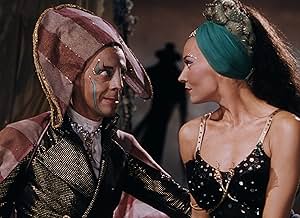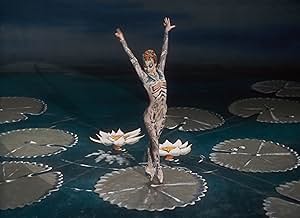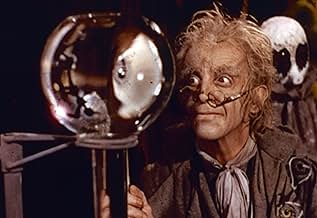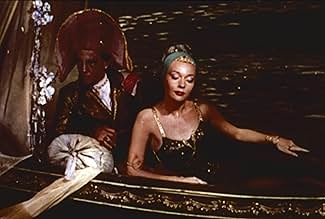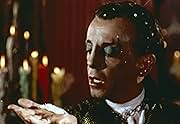Adicionar um enredo no seu idiomaA melancholy poet reflects on three women he loved and lost in the past: a mechanical performing doll, a Venetian courtesan, and the consumptive daughter of a celebrated composer.A melancholy poet reflects on three women he loved and lost in the past: a mechanical performing doll, a Venetian courtesan, and the consumptive daughter of a celebrated composer.A melancholy poet reflects on three women he loved and lost in the past: a mechanical performing doll, a Venetian courtesan, and the consumptive daughter of a celebrated composer.
- Direção
- Roteiristas
- Artistas
- Indicado a 2 Oscars
- 2 vitórias e 3 indicações no total
- Giulietta
- (as Ludmilla Tcherina)
- …
- Spalanzani
- (as Leonide Massine)
- …
- Olympia
- (canto)
- …
- Giulietta
- (canto)
- …
- Nicklaus
- (canto)
- …
- Spalanzani
- (canto)
- …
Avaliações em destaque
In "The Tales of Hoffmann", Robert Rounsevill stars as E.T.A. (Ernst Theodore Amadeus) Hoffmann, the poet and writer who tells three stories of his great but unhappy loves all ending tragically thanks to the meddling of his enemy, a supernatural villain (Robert Helpmann as quadruple evil, Lindorf, Coppelius, Dapertutto and Dr Miracle). Objects of Hoffmann's love and admiration include Olympia the wind-up doll (Moira Shearer who also plays Stella the dancer, the fourth and yet another Hoffmann's misadventure), Giulietta, the Venetian courtesan who sails away after trying to capture Hoffmann's soul (Ludmilla Tchérina -absolutely brilliant as the siren and the seductress who elegantly walks over the dead bodies, literally), and Antonia the beautiful opera-singer with the fatal voice and deadly illness. One of the greatest choreographers and dancers of the last century, Léonide Massine shines in three absolutely different roles demonstrating his talent as a dancer, strong emotions and tremendous humor.
What makes "The Tales of Hoffmann" not just an ordinary screen adaptation but the stunning unforgettable event, the film which had inspired the future famous directors George Romero and Martin Scorsese to become the filmmakers is the perfect combination of fantasy, classical music, ballet, singing, stunning visual effects, imaginative and often bizarre and even disturbing images that would fit a horror movie (deconstructing Olympia the doll is horrifying), incredible but calculated feast of colors, their mixture, the unique color palette to match each story, camera work that is so innovative and dynamic that even now, 56 years after the film was made, looks fresh and modern. The feast for eyes, ears, and feelings, "The Tales of Hoffmann" is the love child of incredibly talented people from different epochs and countries. The opera by Jacques Offenbach, the French composer is based on the dark romantic fairy tales by the German E.T. A. Hoffmann. The team of two directors known as "The Archers", the British Michael Powell and the Hungarian Jew Emeric Pressburger who had to flee his country before the WWII, and their international team of stars, color consultants, choreographers and production designers made this miracle happen. The last but not the least is legendary Sir Thomas Beecham conducting the Royal Philharmonic Orchestra.
However, unlike THE RED SHOES, HOFMMAN is a much colder experience. For a film about the joys and sufferings of love and desire, the whole thing is quite remote, never reaching the emotional depth of other Powell and Pressburger films. The whole thing feels overlong and if you aren't an opera fan, you aren't likely to take to the music either.
The three sequences which make up the runtime are uneven: the Olympia story is whimsical and fun though a touch overlong; the Giuletta sequence is gothic and well-paced; the Antonia sequence is just about the worst. Olympia and Giuletta benefit from having charismatic performers at their center in Moira Shearer and Ludmilla Tcherina, but Ann Ayars lacks any real personality as the dying songstress, making the last section such a drag to sit through.
By the time the film came to its close, I was more than ready for it to be done with. No doubt, a lot went into the sets, costumes, special effects, and camera work. I must also give a shout-out to Robert Rounseville as Hoffman: he carries himself well throughout the long running time. But I'm sorry to be the naysayer: when a movie is over two hours long, I need more than gorgeous visuals to see me through it.
In the story a poet Hoffman tells in episodic fashion about the many times that he has loved and lost. There have been several films made with such a theme but Hoffman stands well apart because of the Goth-fantastic nature of the narratives. Hoffman, in turn, falls in love with Olympia - a puppet, Guiletta - the temptress of a soul-stealing demon, and Antonia - a singer doomed by fatal consumptive illness.
This narrative is complemented by the brilliantly supportive artistic design of the film. The makers construct a deliberate stage-like ambiance, with the use of representative backdrops, suitably exaggerated props and striking motifs to convey the settings and moods of the various episodes. In this aspect it shares strong kinship with Masaki Kobayashi's period ghost story anthology Kwaidan. You also have the concept of the same actor returning to play different parts in the various episodes of Hoffman's life, the most notable of which is Robert Helpmann who portrays the sinister element in all the episodes (and with his vampiric menacing look, does a terrific job of it, although his motive for evil in the Antonia episode goes unexplained).
The fantastic elements of the plot, color-drenched distinctive look, intricate balletic choreography and excellent fit of all the actors in their roles make Tales of Hoffman a very interesting watching experience on the whole.
One of my caveats with the film is that Hoffman's companion Nicklaus is never properly explained. Who is this woman in man's garb and why is she doing what she does?
Você sabia?
- CuriosidadesGeorge A. Romero, writer/director of A Noite dos Mortos-Vivos (1968) and Zombie - O Despertar dos Mortos (1978) has cited this as his all-time favorite movie, saying that it was the one that originally inspired him to get into filmmaking.
- Erros de gravaçãoGiulietta's necklace is turned from jewels to wax by Dapertutto, however, in a longer shot, it is briefly shown as jewels again, before a close-up, where it is wax again until Dapertutto changes it back to jewels.
- Citações
Chorus of Students: Some drink, drink, drink, drink, drink: do you hear us about? You lazy lout! We want some beer; we want some wine! Pour out the wine, and drink and drink till morning. Pour out the wine for drinking is divine. It is divine. We want some beer; we want some wine. We want some beer; we want some wine.
- Cenas durante ou pós-créditosIn the end credits, main actors appear taking curtain calls next to the singers who dubbed them.
- Versões alternativasThe complete 138-minute version was available in 16mm black and white early television prints. The complete 138-minute version was also available in 16mm Kodachrome (color) rental prints. The complete 138-minute soundtrack was available for many years on LP (London Records).
- ConexõesFeatured in The Late Show: Michael Powell (1992)
- Trilhas sonorasThe Tales of Hoffmann, A Fantastic Opera
Music by Jacques Offenbach
Arranged by Thomas Beecham (uncredited)
English libretto by Dennis Arundell
From the French text by Jules Barbier
Conductor: Thomas Beecham (as Sir Thomas Beecham Bart.) with The Royal Philharmonic Orchestra
Sung by Robert Rounseville, Dorothy Bond, Margherita Grandi, Ann Ayars (as Ann Ayars), Monica Sinclair, Joan Alexander, Grahame Clifford, Bruce Dargavel, Murray Dickie, Owen Brannigan, Fisher Morgan, Rene Soames, and The Sadler's Wells Chorus
Principais escolhas
Detalhes
- Data de lançamento
- País de origem
- Idioma
- Também conhecido como
- Contos de Hoffman
- Locações de filme
- Empresas de produção
- Consulte mais créditos da empresa na IMDbPro
Bilheteria
- Faturamento bruto nos EUA e Canadá
- US$ 91.930
- Fim de semana de estreia nos EUA e Canadá
- US$ 23.340
- 15 de mar. de 2015
- Faturamento bruto mundial
- US$ 140.714
- Tempo de duração2 horas 13 minutos
- Proporção
- 1.37 : 1
Contribua para esta página




